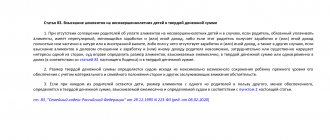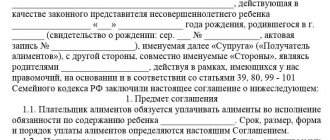- home
- Reference
- Old age pension
Parents must provide care for minor children even while retired. Therefore, alimony is also withdrawn from old-age pensions. Since this monetary assistance is awarded by the state, it is impossible to hide its size .
Depending on the type of social assistance, the father may pay a different amount. Parents can agree on this independently. If an agreement cannot be reached, they go to court.
Types of pensions from which alimony is paid
The provisions of the Family Code of the Russian Federation regulate the procedure for paying alimony from wages or other source of profit. Government Decree No. 841 contains a list of income from which alimony is collected in favor of children under the age of majority. The pension is included in this list, so funds are also withheld from it.
Pension legislation distinguishes several types of pensions:
- upon reaching old age;
- for awarding disability status;
- military pension;
- military veteran's pension;
- pension of an employee of the Ministry of Internal Affairs.
The only type of pension from which alimony payments are not withheld is the survivor's pension. It is not considered the main source of income. Based on the provisions of Resolution No. 841, all individuals receiving a pension make alimony payments, regardless of the source of profit.
When calculating alimony payments, not only monthly increases are taken into account, but also bonuses and additional payments to the pension. The total amount that the alimony payer receives monthly is calculated. On its basis, the size of shares when paying alimony is determined.
Is alimony payable from a funded pension?
In accordance with paragraphs 9, 12, 17 of Art. 101 of the Federal Law of October 2, 2007 No. 229-FZ “On Enforcement Proceedings”, the funded pension belongs to the category of income from which collection cannot be levied.
Shape, size and features of collection
In accordance with the Family Code, the maintenance of minor children, spouses, parents and other relatives can be carried out in the following forms:
- Fixed monthly cash payment.
- A certain percentage of the income of the person obliged to provide maintenance.
- In other forms determined by the parties independently (for example, an agreement between spouses may provide for the transfer of real estate into the ownership of one of the spouses in exchange for maintenance, etc.).
The amount of the penalty may also vary and depends on factors such as:
- level of welfare of the alimony recipient;
- the amount of income of the obligated person;
- in relation to which of the relatives the person has an obligation to provide maintenance, etc.
Specific forms and sizes, as well as methods of collection, are determined by a judicial act or agreement of the parties. Let's consider some situations.
For the maintenance of a child (one, two, three, from different marriages)
If there is no agreement between the parents on the form and amount in which maintenance is provided for a child under the age of 18, alimony is collected in court. The law provides for 2 forms of recovery in this case:
- As a general rule (if the obligated person has regular income) - in the form of a fractional share of all income.
- In the form of an amount of a set amount, also paid every month, if the person does not have an official monthly income or there are other specifics in his earnings.
The size of the share withheld from income depends on the number of children for whom maintenance is sought:
| No. | Number of minor children | Collected share |
| 1 | 1 | 25% |
| 2 | 2 | 1/3 |
| 3 | 3 or more | 50% |
The indicated sizes of shares do not depend on whether these children were born from the same marriage or from different ones. The amount of deductions is divided proportionally among all recipients in equal shares.
Maintenance of a spouse or ex-spouse
It is established in the form of a fixed payment, taking into account the financial situation of both parties during the marriage and after its termination.
For the maintenance of parents
They can be paid by agreement of the parties, and in the absence of this document, they can be collected in court in the form of a fixed amount paid monthly. Only disabled parents can apply for such support.
For which payments to pensioners alimony is not charged?
The legislation of the Russian Federation provides for a number of cases in which a pensioner is exempt from paying alimony. Each of them concerns a certain type of subsidies - cash payments from the state in support of special categories of citizens.
Alimony is not charged for:
- survivor pensions;
- financial assistance to disabled people of groups 1 and 2;
- compensation for damage to health;
- payments for treatment and purchase of medications;
- subsidies for travel to places of health.
The listed types of pensions are not considered sources of income for citizens. They are not taken into account when calculating the amount of alimony shares.
A pensioner is exempt from paying alimony under the following conditions:
- commission of illegal actions on the part of the recipient;
- children reaching adulthood and official employment;
- adoption of a child;
- death of the alimony payer or recipient.
If the alimony payer dies, his obligations to pay alimony are canceled by the court. In this case, the recipient is paid a new pension - for the loss of a breadwinner.
Responsibilities of the Pension Fund for calculating and sending payments
From the date of receipt of executive documents, PF employees must withhold funds in accordance with the data specified in them. Within three days, starting from the day the pension is paid, they are obliged to transfer or pay alimony to the recipient. Transfers and transfers are made at the expense of the alimony provider.
The pension fund stops calculating and paying alimony in cases where:
- the money has been transferred in full;
- the place where you receive your pension has changed;
- the claimant wrote a statement;
- the bailiff issued a decision to cancel, terminate or terminate the execution.
No later than the day following the day on which the specified grounds occur, PF employees must return to the recoverer or bailiff the document received from one of them (the original in the first case and a copy in the second). At the same time, a mark is placed in it indicating:
- the basis for the end of payments;
- the period of time during which the document was in the Pension Fund for execution;
- the amount that was collected - in case of partial execution.
In this case, the debtor is obliged to inform the claimant and the bailiff about the new place of receiving the pension without any delay.
Alimony from old age pension
Old-age labor pension is financial assistance from the state when a citizen reaches the appropriate age. In our country, it is 55 years for women and 60 years for men. A prerequisite for receiving a labor pension: a citizen must deduct part of the taxes from his salary to the state every month for at least 15 years. In other circumstances, the individual is awarded a social pension.
The labor pension is included in the list of the main sources of income for a citizen. A small percentage of citizens continue to work upon reaching retirement age. In this case, the old-age pension is not their only source of income. However, alimony from the old age pension will be withheld from him.
Alimony from a military man's pension
Military personnel do not belong to the category of citizens exempt from paying alimony from a military pension. By law, they are required to pay a specified amount monthly for the maintenance of minor children.
When calculating alimony from a military personnel’s pension, all sources of military personnel’s income, including pensions, are taken into account. Citizens of this profession have special privileges: their retirement age comes much earlier than others. This is explained by the fact that their work is dangerous and can become a source of serious diseases.
To become a military pensioner, it is enough to have preferential service.
This includes:
- participation in hostilities;
- assistance in emergency response;
- work with nuclear weapons;
- work as a pilot;
- service in the highlands.
To receive preferential length of service, a citizen must serve as a military personnel for at least 20 years. After this, he is given the opportunity to become a long-service pensioner. Some manage to retire after 30, others after 50. Reaching retirement age for a military serviceman is directly related to the speed of receiving preferential service.
Alimony from a working pensioner
Alimony from a working pensioner is withheld from his salary and pension (with the exception of payments for the loss of a breadwinner). Payment of alimony from a working pensioner occurs in two ways. The first is in a fixed size. This option is most often found in practice if an individual does not have official income. The second is in percentage terms. The amount of alimony payments is calculated based on monthly income and the number of recipients.
The legislation establishes the following standards:
- 1/4 – for 1st child;
- 1/3 – for 2 children;
- 1/2 – for 3 or more children.
For example, citizen A. Afanasyev pays alimony from his old-age pension for 2 children. The pension amount is 18,000 rubles. Alimony payments in this case will be: 18,000 / 3 = 6,000 rubles.
The labor pension is paid regularly. Every year it is subject to indexation and recalculation.
Amount of child support from pension
The amount of alimony is determined in two ways. The first one is the most loyal and calm. Parents independently agree on the amount of child support payments. The second is strict and coercive. A court order sets the amount of alimony.
Despite the fact that both options have the same goal - determining the amount of alimony payments - the final amounts may differ significantly from each other.
The procedure for determining alimony payments is presented in the table.
| Through peaceful negotiations | By the tribunal's decision | |
| Procedure for assigning alimony | The alimony payer and the recipient come to a consensus and enter into an agreement on the payment of alimony. It indicates the amount reached as a result of the agreements. It should not be lower than the minimum established by the legislation of the Russian Federation. | The court thoroughly examines the sources of income of the alimony payer. Then he forces you to pay alimony as a percentage (if you have official employment) or a fixed amount of money (if you don’t have a job). |
| Minimum amount | At least ¼ of income for 1 child, 33% for 2 children, 50% for 3 children. | At least ¼ of income for 1 child, 33% for 2 children, 50% for 3 children. |
| Maximum amount | Has no restrictions, but must be greater than the minimum. | No more than 70% of the pensioner’s total income. |
| Change of size | This is done by amending the alimony agreement. The size of payments can be either reduced or increased. | By filing an additional claim. It must indicate the reason for changing the amount of alimony payments. |
In practice, events may take an unexpected turn. For example, citizen Nikolaev A. is a pensioner of the Ministry of Internal Affairs. His work activity consists of hired work. Nikolaev A. enters into an agreement with his wife on the payment of alimony. The established amount is 20% of the pensioner’s salary. Despite the obligations, citizen A. insistently refuses payments. His wife goes to court for help. Her demand is to cancel the agreement and collect alimony from A. Nikolaev in the amount of ¼ of his salary. Receives a refusal, justified by the fact that the agreement of the spouses initially did not comply with legislative norms - the amount of alimony payments cannot be less than 25% of the total profit (Article 81 of the RF IC). According to the terms of the agreement, it was only 20%.
Another example. Citizen K., by court decision, is obliged to pay alimony for the maintenance of a minor child in the amount of 30% of wages. After some time, the pensioner becomes disabled. He goes to court with a claim demanding a reduction in the amount of payments due to disability and, as a consequence, unemployment. The evidence base was the conclusion of a medical and social examination. Citizen K. is recognized as a disabled person of the 3rd group. The court denies the applicant his demands. According to the law, the pensioner receives a new source of income - a disability pension. It allows him to pay alimony in the same amount.
Arbitrage practice
Typically, courts are primarily guided by the interests of children, but the rights of pensioners are also taken into account. The financial situation of the latter also plays a significant role.
Here are some examples of real solutions:
- The plaintiff wanted to change the method of collection from equity to TDS, and demanded reimbursement of additional expenses for the child’s education from the defendant-pensioner. By decision No. 2-58/2020 2-58/2020~M-2/2020 M-2/2020 dated February 26, 2021, in case No. 2-58/2020, the claims were denied.
- The woman was thinking of collecting alimony from her retired husband in the TDS for two children in the amount of one monthly minimum. By decision No. 2-956/2020 2-956/2020~M-804/2020 M-804/2020 dated May 13, 2021 in case No. 2-956/2020, the requirements were partially satisfied. 1/3 of all income was collected for alimony, plus 1/5 for each child.
- The plaintiff applied to the court with a request to dissolve the marriage and collect alimony for the children she shared with the defendant. Decision No. 2-297/2019 2-34/2020 2-34/2020(2-297/2019;)~M-324/2019 M-324/2019 dated February 4, 2021 in case No. 2-297/2019 the demands were partially satisfied, the marriage was dissolved.
How to reduce alimony payments from a pension
In practice, you can often find pensioners in court demanding the cancellation of their alimony obligations. They cite advanced age and disability as the reason.
Attempts to escape financial obligations to the child end in failure. The current legislation of the Russian Federation does not provide for exemption from alimony payments for pensioners. At the same time, the amount of remittances cannot fall below the minimum value established by law.
The alimony payer, whether he is a pensioner, an unemployed person or a working citizen, must pay alimony.
Voluntary agreement on the payment of alimony from a pension
A voluntary agreement on the payment of alimony from a pension is concluded when the payer is consciously ready to pay part of his income. This method is the fastest. To conclude a document, it is enough to provide two copies of the agreement. It must indicate payment terms and specific monetary amounts.
A voluntary agreement takes on legal force only after passing through the hands of a notary. In the future, this procedure will facilitate the collection of alimony if the pensioner stops paying it. It will be enough to turn to bailiffs, bypassing lengthy court proceedings.
Required documents
In order to start the collection process, you must have a court decision and a writ of execution. This can be issued and certified in Arbitration or ordinary courts. A court order on the possibility of foreclosure is also required. In general, bailiffs do all the work. They make sure that there are no debts, negotiate with negligent payers, and submit documents to the court to foreclose on the property.
The mother is usually not required to provide any documentation other than providing a court decision and personal documents.








